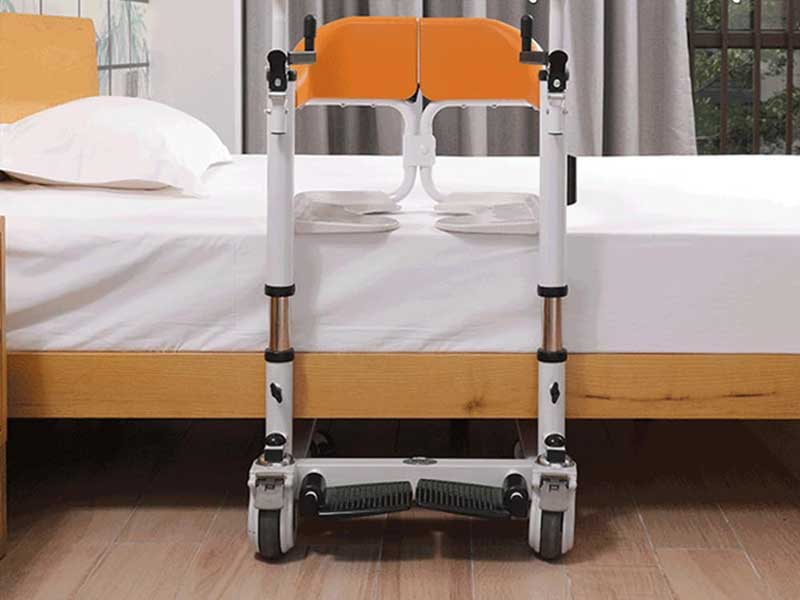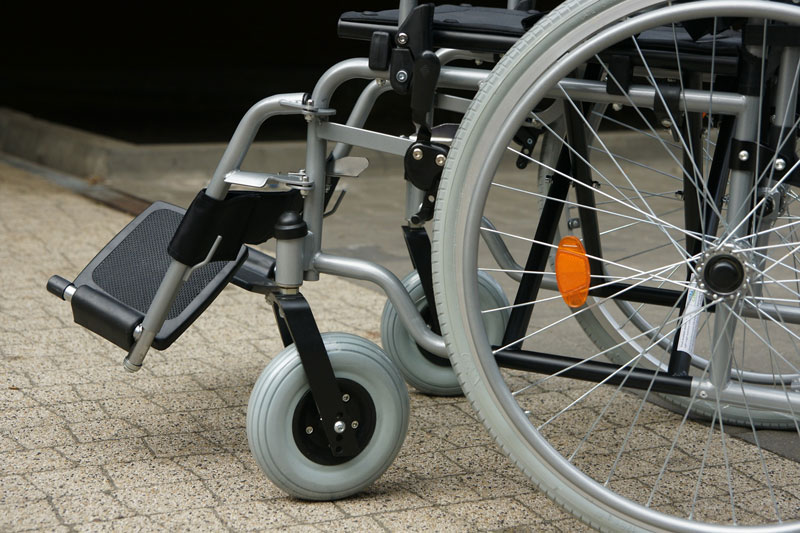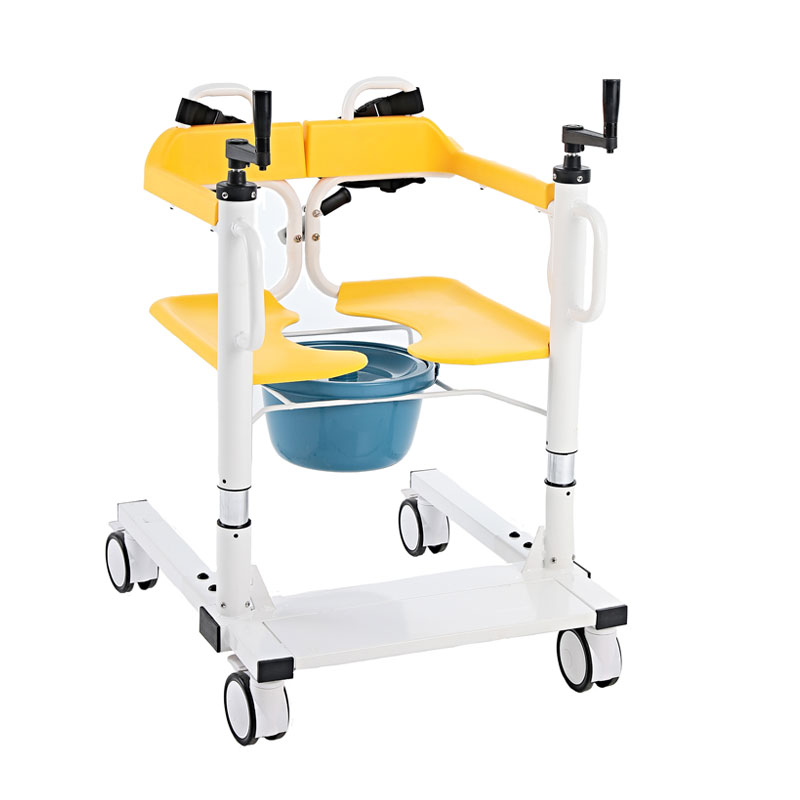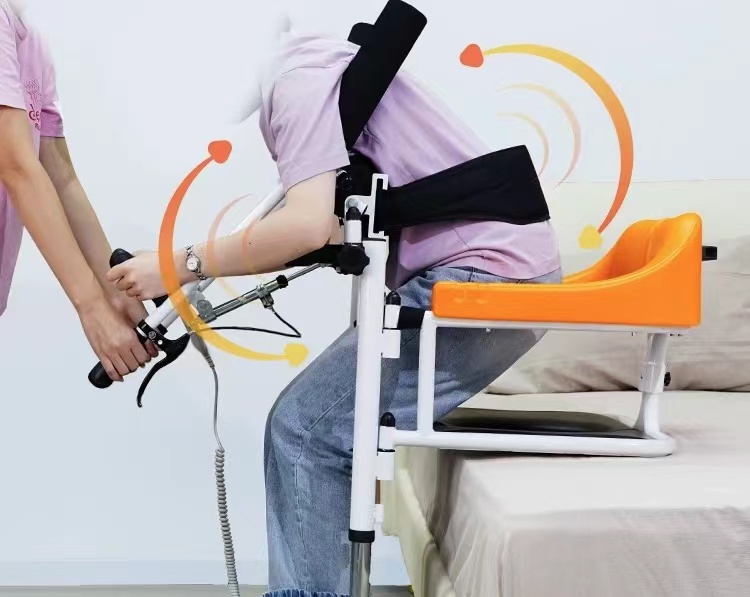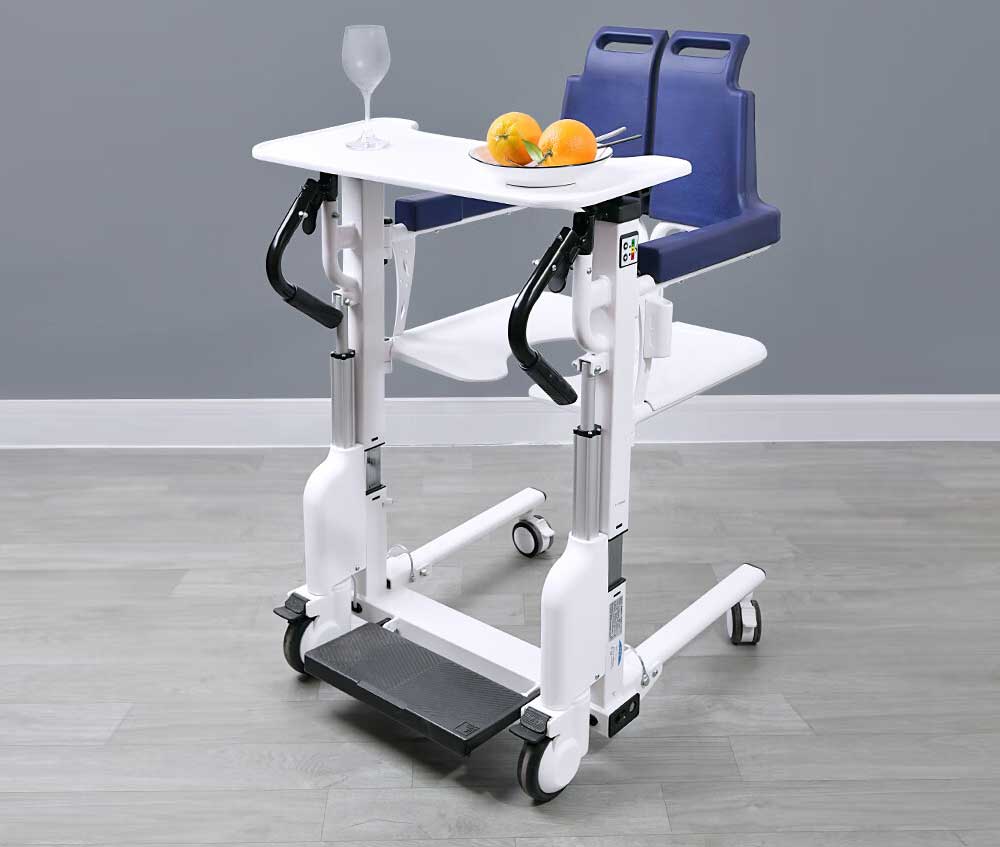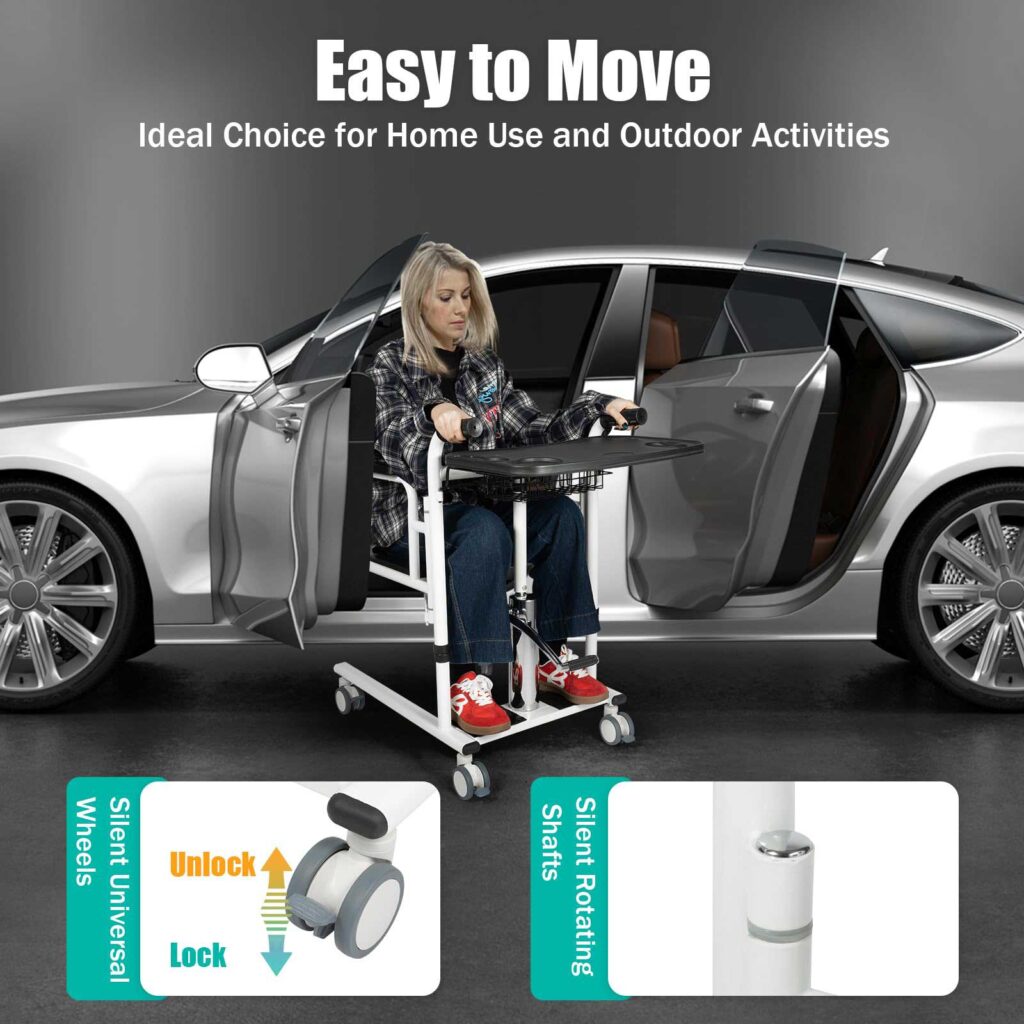An electric transfer chair (also called an electric patient lift transfer chair or electric patient transfer chair) is a motorized mobility device designed to help individuals with limited strength or mobility move safely between different surfaces using an electric motor for effortless, independent or assisted transfers.
Key Features of Electric Transfer Chairs
Unlike traditional transfer chairs, the operation of electric transfer chairs mainly relies on motors, hydraulics, control systems and batteries.
These features are the core elements that ensure the normal operation of electric transfer machines. You need to pay special attention to these performance characteristics when making a purchase.
Electric Transfer Chair Motor
The heart of the electric transfer chair is its powerful yet quiet electric motor, which drives all primary functions. This motor operates using rechargeable batteries, ensuring that the chair remains functional without the need for constant plugging into a power source.
As a modern assistive mobility device, the core power source of an electric transfer transfer is the drive motor. According to technical features and cost considerations, the common drive motors on the electric transfer chair market are mainly divided into two types: brushed DC motors and brushless DC motors (BLDC).
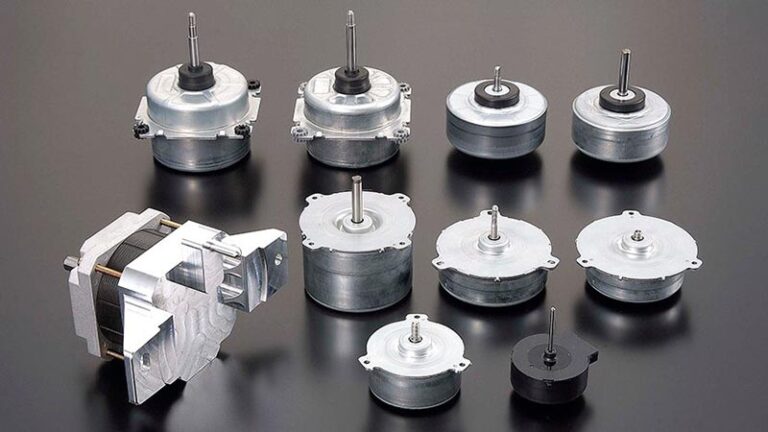
The brushed DC motor has a simple structure and low cost, but the carbon brushes are prone to wear, with low efficiency and high noise.
The brushless DC motor has a long lifespan, high efficiency and runs quietly, but it has a high cost and a complex control circuit.
These two types of motors have their own advantages and disadvantages and are suitable for the design of transfer chairs with different requirements.
The battery life of the electric transfer chair is typically long enough to accommodate multiple uses before requiring recharging, making it ideal for daily activities. It can provide powerful driving force and long-lasting power supply guarantee for the motor.
Powered Lifting Mechanism of An Electric Transfer Chair
The electric transfer chair’s powered lifting mechanism enables users to transition smoothly between seated and standing positions, or vice versa, with minimal exertion. This mechanism is designed to accommodate a range of weights safely and efficiently, offering reassurance to both users and caregivers.

Here are common driving methods for electric transfer chairs.
1. Electro-Hydraulic Transfer Chair
The Electro-Hydraulic Transfer Chair drives the hydraulic pump through an electric motor to push the hydraulic cylinder for lifting and translation.
Features of Electro-Hydraulic Transfer Chair:
- High stability: The electro-hydraulic system can provide stepless speed regulation, with smooth movement, making it suitable for sensitive patients.
- Strong load capacity: Suitable for users with large weights (such as medical transfer chairs for those over 200 kg).
- Relatively complex maintenance: It is necessary to regularly check the hydraulic oil seal. Oil leakage may occur after long-term use.
Applicable scenarios of Electro-Hydraulic Transfer Chair:
- Places that require high stability, such as hospitals and rehabilitation centers.
2.Electric Screw Drive Transfer Chair
The Electric Screw Drive Transfer Chair motor drives the precision lead screw to rotate, which is converted into linear motion to achieve lifting.
Features of Electric Screw Drive Transfer Chair:
- High precision: The lifting position is controllable, suitable for scenarios that require fine adjustment.
- Compact structure: Occupies less space, suitable for home use or narrow environments.
- Relatively slow speed: The transmission efficiency of the lead screw is lower than that of hydraulic or chain drive.
Applicable scenarios of Electric Screw Drive Transfer Chair:
- Home care, light transfer needs.
3.Electric Chain/Belt Drive Transfer Chair
The Electric Chain/Belt Drive Transfer Chair motor drives the chain or belt through a gear set to lift and lower the boom.
Features of Electric Chain/Belt Drive Transfer Chair:
- High speed: More efficient than hydraulic and lead screw drives, suitable for frequent operations.
- Relatively high noise: The chain drive may generate friction noise.
- Regular lubrication required: The chain/belt needs to be maintained to prevent wear.
Applicable scenarios of Electric Chain/Belt Drive Transfer Chair:
- Scenarios in nursing homes, care institutions, etc. where rapid transfer is required.
4.Direct Drive Motor Transfer Chair
The Direct Drive Transfer Chair motor is directly connected to the lifting mechanism without intermediate transmission components (such as hydraulics or chains).
Features of Direct Drive Motor Transfer Chair:
- Fast response: The power transmission is direct with low delay.
- Low maintenance: There are no problems of hydraulic oil or chain wear and tear.
- High cost: The technical threshold is relatively high, and it is more commonly seen in high-end models.
Applicable scenarios of Direct Drive Motor Transfer Chair:
- High-end nursing equipment or intelligent transfer machines.
The driving mechanism of an electric patient lift chair and mobility transfer device has a direct impact on its safety, stability, and applicable scenarios.
This feature is particularly beneficial for individuals with limited mobility, as it reduces the strain on caregivers during transfers.
Push-Button Controls in An Electric Transfer Chair
For added convenience, electric transfer chairs come equipped with intuitive push-button controls. These controls can be easily operated by either the patient or the caregiver, depending on the user’s needs and abilities.
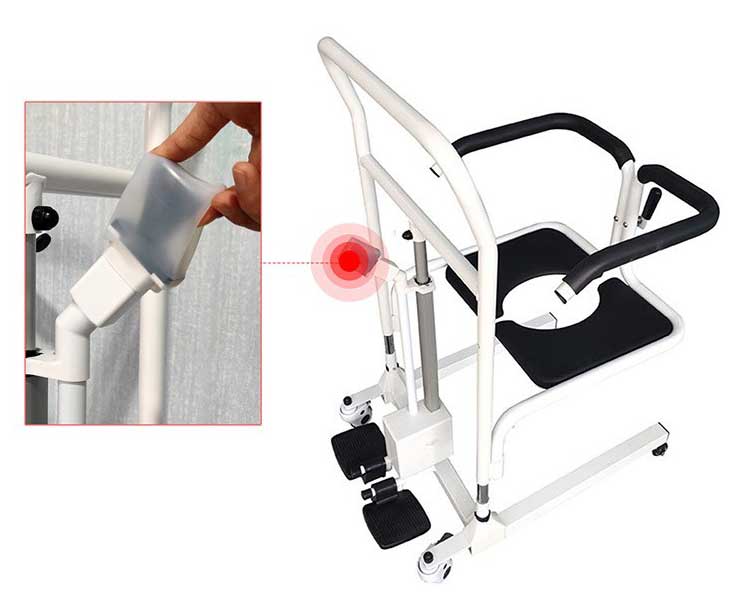
The push-button controls of an electric transfer chair are typically located on an intuitive, easy-to-use armrest panel.
These buttons allow users to adjust the chair’s position with minimal effort. For instance, by pressing one button, the user can smoothly elevate the chair to a standing position, while another button lowers it back to a seated position.
This simple mechanism is particularly beneficial for those who experience difficulty in lifting themselves due to conditions such as arthritis, muscle weakness, or post-surgery recovery.
Moreover, modern electric transfer chairs often come equipped with advanced features controlled via these buttons. Some models offer adjustable backrest angles for enhanced comfort during prolonged sitting, while others may include reclining options for relaxation or improved circulation.
Certain high-end versions even provide programmable settings and remote control, allowing users to save their preferred positions for quick access at the touch of a button. Safety is another key aspect addressed by push-button controls and remote controllers can also enhance the safety and emergency operation capabilities of elderly people when they use electric transfer chairs.
Many chairs incorporate fail-safe mechanisms that stop the movement if excessive resistance is detected, preventing injury. Additionally, some designs feature wireless remote controls as an alternative to physical buttons, catering to users with limited hand dexterity.
The buttons are strategically placed for easy access and are often labeled clearly to prevent confusion. This design ensures that even those with limited dexterity can manage the chair’s functions with confidence.
In summary, the push-button controls of electric transfer chairs represent a significant advancement in assistive technology. By combining ease of use, customization options, and safety features, they empower individuals to maintain independence and improve their quality of life.
Electric Transfer Chair Smooth Height Adjustment
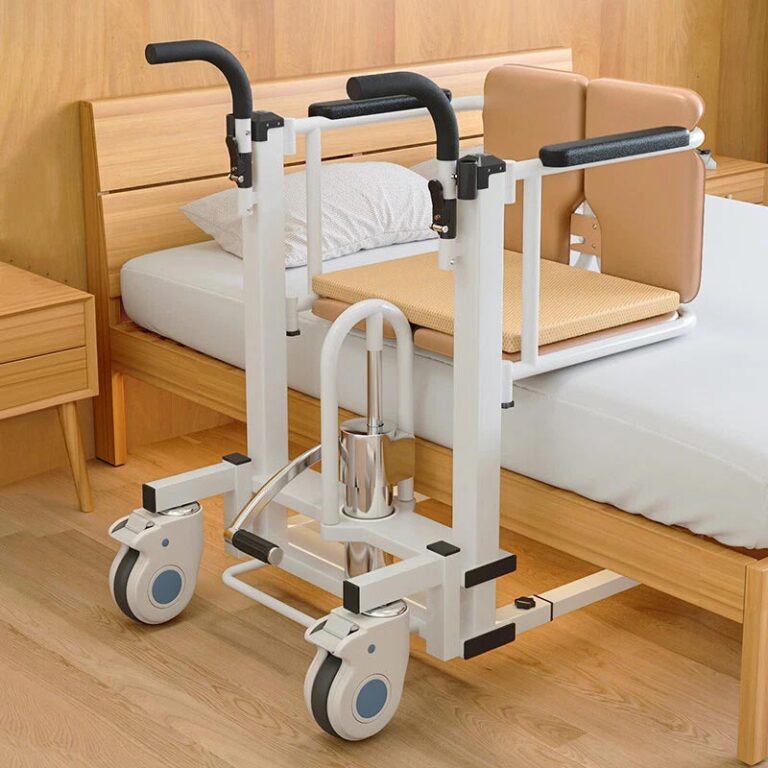
Electric transfer chairs are innovative devices designed to assist individuals with mobility challenges, providing them with greater independence and comfort during transfers.
These Electric Transfer Chairs are equipped with advanced features that enhance usability and ensure a seamless experience for both patients and caregivers.
They have the ability to provide smooth height adjustment without requiring any manual effort.
This functionality is achieved through an integrated electric system that allows users or caregivers to effortlessly adjust the chair’s height at the touch of a button. This feature is particularly beneficial for individuals who may struggle with physical exertion or have limited strength in their arms or hands.
By eliminating the need for manual adjustments, these Electric Transfer Chairs reduce the risk of strain or injury, making transfers safer and more convenient. For example, when transferring someone from a bed to a wheelchair, the chair can be adjusted to match the height of the bed, ensuring a stable and comfortable transition.
Quiet Motor Operation
Another key advantage of electric transfer chairs is their quiet motor operation, which prioritizes patient comfort.
The motors used in these chairs are specifically designed to minimize noise while maintaining efficiency and power.
This is crucial in healthcare settings or home environments where peace and quiet are essential for patient well-being. A quieter operation also helps to create a calming atmosphere, reducing anxiety or discomfort during transfers. Patients often appreciate this feature as it makes the process feel more natural and less intrusive.
In addition to these core features, electric transfer chairs are typically constructed with durable materials and ergonomic designs to support long-term use and enhance user comfort.
Many models also include additional safety features such as automatic braking systems, non-slip surfaces, and adjustable armrests to accommodate a wide range of daily use.
Safety Features of Electric Transfer Chair
Electric transfer chairs are designed to assist individuals with limited mobility in safely moving between different surfaces, such as a bed and a wheelchair or a chair and a toilet. These chairs come equipped with a variety of safety features to ensure the well-being of the users.
Intelligent Safety Protection Mechanisms
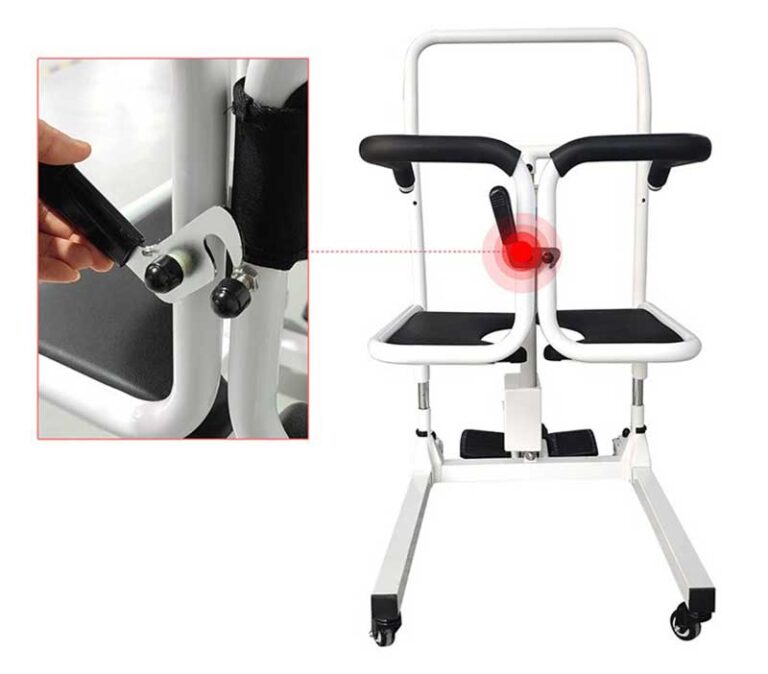
Some high-end models electric transfer chairs are equipped with highly advanced intelligent safety protection mechanisms that operate seamlessly during both movement and lifting processes. These mechanisms are designed to detect various potential hazards in real-time.
During movement, sensors are installed at the base of the chair to monitor the terrain. If the electric transfer chair encounters an uneven surface, such as a small step or a significant bump, the intelligent system can automatically adjust the speed or even halt the movement to prevent tipping or jolting the user.
For example, if the front – end sensors detect a height difference of more than 2 centimeters, the electric transfer chair’s motor will gradually reduce its rotational speed until it comes to a complete stop.
When it comes to the lifting function, multiple sensors work in harmony. There are sensors on the lifting arms that measure the weight distribution of the user. If the weight is not evenly distributed, or if the total weight exceeds the chair’s rated capacity, the lifting mechanism will immediately stop to avoid overloading and potential structural damage.
Additionally, sensors on the vertical guides of the lifting system ensure that the chair is ascending and descending in a straight and stable manner. Any deviation from the normal vertical path will trigger an automatic correction or a stop command.
However, you should know that the regular model of the electric transfer chair does not have sensor monitoring function. The safety of the rider still needs to be controlled by family members or caregivers to ensure stable center of gravity and safe driving speed.
Emergency Stop Controls
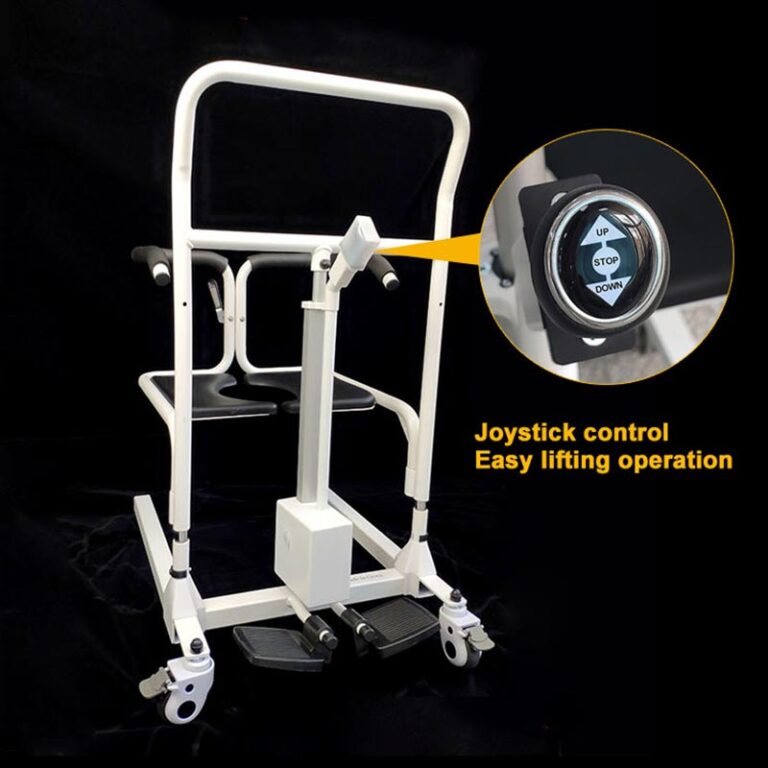
To ensure the safety, the electric transfer chair is furnished with easily accessible emergency stop controls. These controls are strategically placed on both the armrests of the chair and on the remote control device that comes with it.
The emergency stop buttons on the armrests are large and clearly marked, making them easy to locate even in a hurry.
In case of any unforeseen situation, such as a sudden obstruction in the chair’s path or a malfunction during movement or lifting, the user or the caregiver can simply press the emergency stop button on the armrest. This will immediately cut off the power supply to the chair’s motors, bringing all movement to a sotp.
The remote control also has an emergency stop function. This is particularly useful when the caregiver is operating the chair from a short distance away. The remote control’s emergency stop button is designed to be distinct from the other function buttons, with a different color and texture for easy identification. Once pressed, it sends a wireless signal to the chair’s control unit, which then enacts the emergency stop protocol, ensuring that the chair stops moving within a fraction of a second.
Safety Locks and Brakes

Safety locks and brakes play a crucial role in securing the electric transfer chair during transfers.
There are two main types of safety locks: wheel locks and transfer belt locks.
The wheel locks are robust mechanisms that can be engaged with a simple foot pedal operation.
These locks are designed to prevent any unwanted movement of the chair’s wheels during the transfer process.
When the electric transfer chair is positioned in place for a transfer, the caregiver can step on the foot pedal, which activates a locking mechanism that tightly grips the wheels. This ensures that the chair remains stationary, even if there are minor vibrations or external forces acting on it.
The wheel locks are strong enough to withstand the weight of the user and any movement associated with the transfer, such as the user shifting their position while getting in or out of the chair.
Electric transfer chair Transfer locks are specifically designed to secure the chair’s lifting and transfer components. These locks are engaged when the chair is in the transfer position. They prevent any accidental movement of the lifting arms or the sling attachment points.
For example, when the chair is lifted to a certain height for a transfer, the transfer locks will engage automatically or can be manually activated. This locks the lifting mechanism in place, so that there is no risk of the chair suddenly dropping or moving during the delicate transfer process.
Stable Sling Systems

The sling system of the electric transfer chair is engineered to be highly stable, with multiple features to prevent falls. The slings straps are made from high – strength, durable High-strength nylon or carbon fiber material that can withstand the weight of the user without stretching or tearing.
The design of the sling is such that it conforms to the body shape of the user. It has adjustable straps that can be customized to fit different body sizes and shapes. These straps are attached to the electric transfer chair ‘s frame using strong and reliable fasteners. The attachment points are reinforced to ensure that they can handle the forces exerted on them during transfers.
Electric transfer chair sling system has a wide base and a deep seat design. This provides a large contact area with the user’s body, distributing the weight evenly and reducing the risk of the user slipping out of the sling.
There are also side supports on the sling, which can be adjusted to provide additional lateral stability. These side supports prevent the user from leaning too far to one side and potentially falling out of the chair during the transfer.
The electric transfer chair sling system is also designed to be easy to clean and maintain, ensuring that it remains in a safe and hygienic condition for continuous use.
Design Elements of an Electric Transfer Chair
The design elements of electric transfer chairs are crucial for ensuring safety, comfort, and ease of use. Below are the key components and considerations that go into designing an effective electric transfer chair.
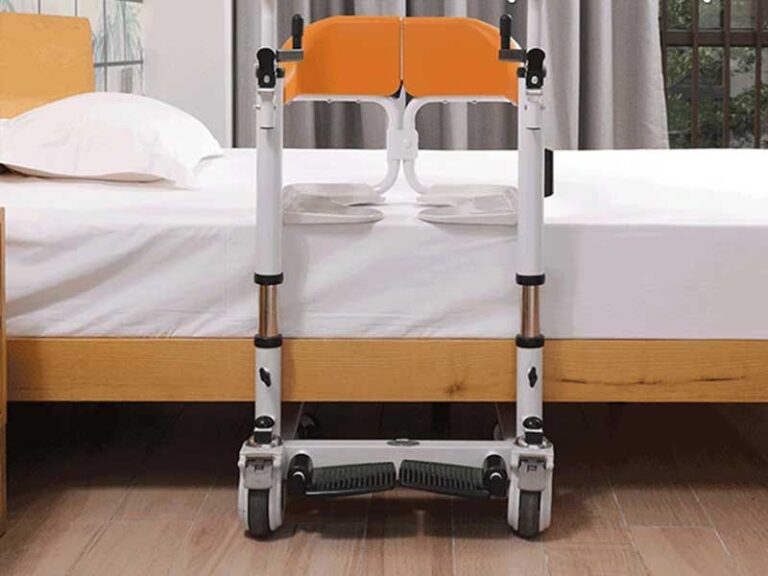
Adjustable Seat Height And Width For Customized Comfort
The seat height of the electric transfer chair is designed to be highly adjustable. It can be raised or lowered within a significant range, typically from 45 cm to 65 cm.
This allows the chair to adapt to different users’ leg lengths and the heights of various surfaces such as beds, toilets, and dining tables.
For example, when transferring a user from a low – lying hospital bed to the chair, the seat height can be adjusted downwards to match the bed height, facilitating a smooth transfer.
The electric transfer chair seat width is also adjustable. It can expand or contract to fit different body sizes. The width adjustment range usually spans from 40cm to 60cm. This feature ensures that users of different body builds, whether slender or more robust, can sit comfortably without feeling cramped or overly loose.
By customizing the seat height and width, the chair can provide a personalized and comfortable seating experience for a wide range of users.
360° Swivel Wheels For Easy Maneuvering In Tight Spaces
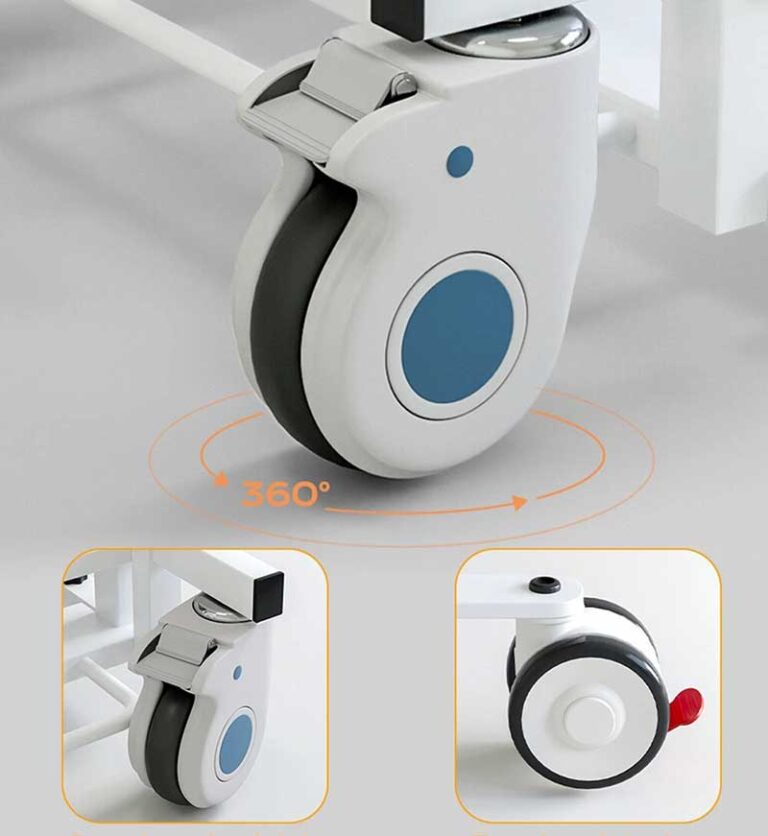
The electric transfer chair is equipped with 360° swivel wheels, which are a crucial design element for enhanced mobility. These wheels are made of high-quality, durable materials such as polyurethane, which offers excellent traction and shock absorption and each wheel can rotate a full 360 degrees independently.
In tight spaces like small bathrooms or narrow hallways, the swivel wheels allow the chair to be easily turned in any direction without the need for large turning radii. This means that caregivers can quickly and smoothly navigate the electric transfer chair around obstacles, corners, and through doorways.
For instance, when moving the chair into a compact toilet cubicle, the swivel wheels enable the chair to be precisely positioned, making it convenient for the user to transfer onto the toilet seat.
Foldable Frame For Storage And Transport
Some of the frame of the electric transfer chair is designed to be foldable, which greatly simplifies storage and transportation.
The frame is constructed from lightweight yet sturdy materials such as aluminum alloy or carbon steel. This material combination ensures that the chair is strong enough to support the user’s weight while remaining easy to manipulate during folding and unfolding.
When it comes to storage, the electric transfer chair foldable frame allows to be collapsed into a compact size. It can be easily stored in a closet, under a bed, or in the trunk of a car. The folding mechanism is designed to be straight forward. Usually, it involves releasing a few locking mechanisms and then folding the frame components together.
For transportation, the folded chair can be carried with relative ease. It can be placed in a standard car trunk without taking up excessive space. Some models even come with carrying handles or straps attached to the folded frame, making it more convenient to move the chair from one location to another.
What you need to know is that for some elderly people with larger body weight, fixed-frame electric transfer machines are usually used, so they are not foldable and relatively heavy.
Split Seat Design (Often 180°) For Toileting Functions
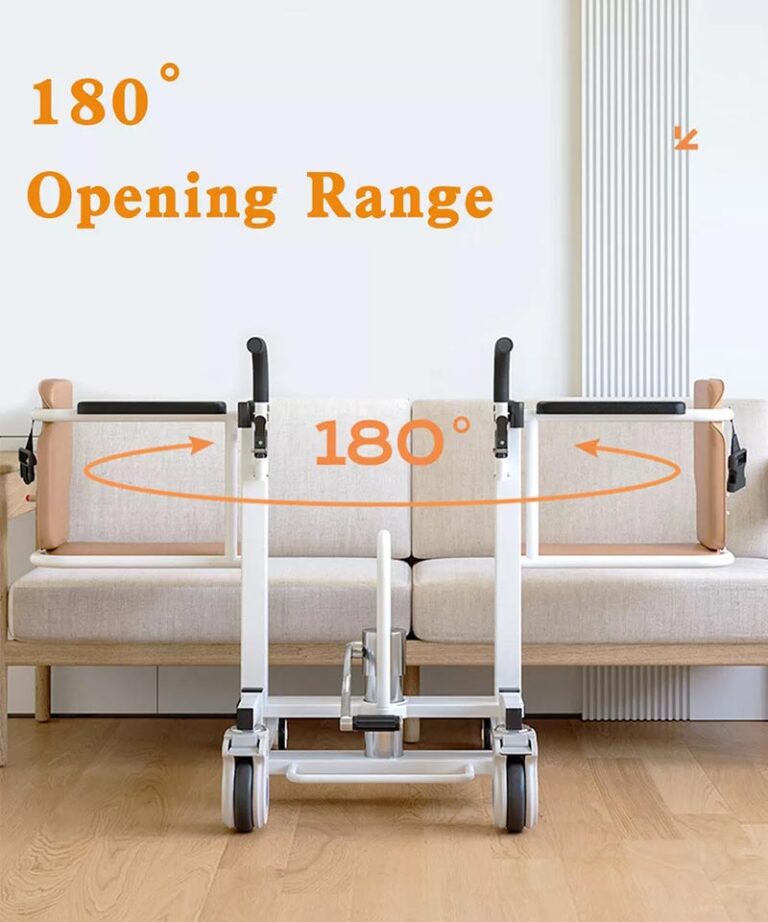
The split seat design of the electric transfer chair, typically with a 180° split, is specifically engineered to facilitate toileting. The two parts of the split seat can be separated, creating an opening that aligns perfectly with a toilet seat. This design eliminates the need for the user to stand up and re-position themselves when transferring from the chair to the toilet.
The split seat is operated smoothly by manual or an electric mechanism. When the user approaches the toilet, the caregiver can activate the control to split the seat. The two halves of the seat move apart in a synchronized manner, providing a seamless transition to the toilet.
After the toileting process, the electric transfer chair’s seat can be easily closed by reversing the operation. This design not only enhances the user’s privacy and dignity but also reduces the physical effort required during the transfer process, making it more convenient for both the user and the caregiver.
Ergonomic Controls Within Easy Reach of Users

The electric transfer chair is equipped with ergonomic controls that are strategically placed within easy reach of the users. These controls are designed to be intuitive and user – friendly. They are usually located on the armrests of the chair, where the user can comfortably rest their hands.
The control panel is designed with large, clearly marked buttons or a screen. Each button has a distinct function, such as adjusting the seat height, width, or operating the split seat mechanism.
The buttons are made of a soft – touch material that is easy to press, even for users with limited hand strength.
In addition, the controls are color – coded for easy identification. For example, the seat height adjustment buttons may be colored blue, while the split seat operation buttons are colored green. This color – coding system helps users quickly find the function they need without having to fumble or read small labels. The ergonomic design of the controls ensures that users can independently operate the chair’s various functions with minimal effort and confusion.
Primary Functions of an Electric Transfer Chair
Electric transfer chairs are sophisticated pieces of equipment designed to provide crucial assistance in various mobility – related scenarios for individuals who may have difficulty with independent movement.
Bed to Wheelchair Transfers:
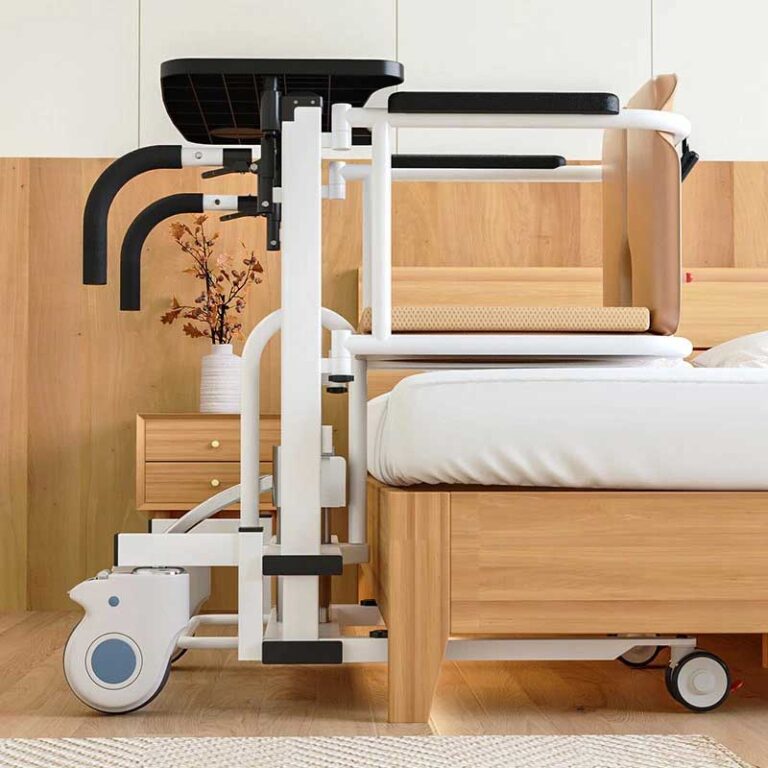
These chairs play a vital role in facilitating the transition from a bed to a wheelchair. When a person is in a bed, the electric transfer chair can be carefully positioned alongside. The chair is equipped with adjustable features such as height – adjustable arms and a seat that can be maneuvered to match the height of the bed. This allows for a smooth and seamless transfer.
The user can then be gently and securely seated in the transfer chair, which can be powered to move away from the bed and towards the wheelchair. Specialized locking mechanisms ensure that the chair is stable during the transfer process, minimizing the risk of falls or injuries.
Toilet and Commode Transfers:
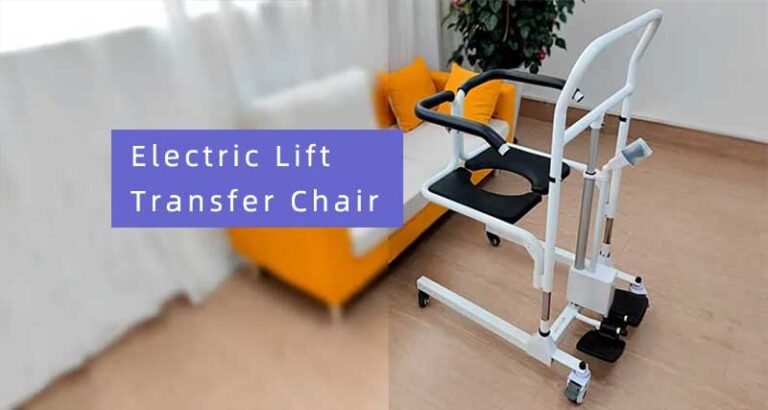
For trips to the toilet or using a commode, electric transfer chairs are invaluable. They can be precisely positioned in front of the toilet or commode. The chair’s design often includes features like swivel seats, which enable the user to easily turn towards the toilet or commode. The height – adjustment function is again crucial here, allowing the seat of the transfer chair to be level with the toilet or commode seat. This makes it possible for the user to move from the chair to the toilet or commode safely. Additionally, some transfer chairs come with support bars that can be used for added stability during the transfer.
Car Seat Transfers:
When it comes to getting in and out of a car, electric transfer chairs simplify the process significantly. The chair can be brought close to the car door.
It has the ability to adjust its height to match the height of the car seat. The user can be seated in the transfer chair and then, with the help of the chair’s electric controls, be moved towards the car seat.
Once in position, the user can easily slide into the car seat. Similarly, when getting out of the car, the transfer chair can be positioned correctly, and the user can transfer back to the chair in a safe and controlled manner.
Chair to Chair Movement:
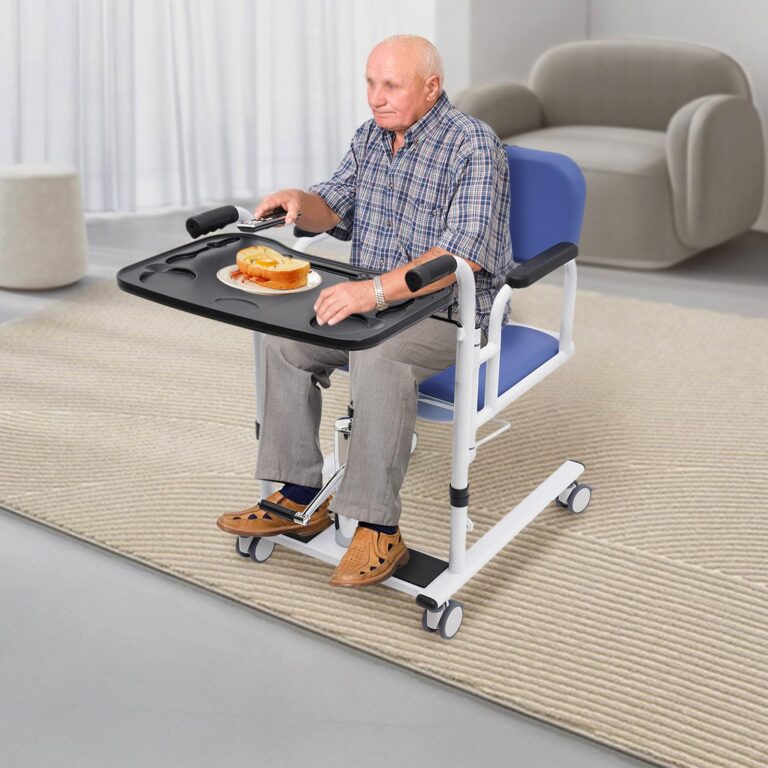
In a home or a care facility, there may be a need to move between different chairs, such as from a living room chair to a dining room chair. Electric transfer chairs are designed to handle these types of transfers.
They can be easily maneuvered around furniture and obstacles. The chair’s smooth – rolling wheels and precise steering controls allow it to navigate through narrow spaces. The user can be comfortably seated in the transfer chair and then transported to the destination chair. The adjustable seat and backrest ensure that the user remains comfortable throughout the transfer.
Bathing and Shower Assistance:
Electric transfer chairs also play a key role in bathing and showering. They can be used to transfer the user from a wheelchair or a regular chair to a shower chair or a bathtub seat. The chair can be adjusted to the appropriate height for the shower or bathtub. Some transfer chairs are even designed to be used directly in the shower area, with water – resistant materials and components. This allows the user to be safely transferred into the shower or bathtub, ensuring that they can receive proper hygiene care without the risk of slips or falls.
Please note that most electric transfer machines are not waterproof. It is recommended to transfer the patient to a shower chair when taking a bath.
Advantages of Electric Transfer Chairs
For Patients:

Reduced Physical Strain During Transfers:
When patients need to be transferred between different surfaces such as a bed and a wheelchair, traditional manual transfer methods often require them to exert a great deal of physical effort.
This can be extremely challenging, especially for those with limited strength, mobility impairments, or recovering from surgeries or injuries. Electric transfer chairs, however, are designed to minimize this physical strain. They use motorized mechanisms to smoothly and gently lift and move the patient, allowing them to avoid the arduous task of pulling or pushing themselves during the transfer process.
This not only reduces the immediate physical stress but also helps prevent potential muscle soreness and fatigue that could result from strenuous transfer attempts.
Increased Independence in Mobility:
Electric transfer chairs play a crucial role in enhancing a patient’s independence. With these chairs, patients who may have previously relied heavily on caregivers for every movement can now initiate and complete transfers on their own to a certain extent.
The user-friendly controls of electric transfer chairs are typically designed to be easily accessible and operable by the patients themselves. This newfound ability to move between different locations independently gives patients a sense of autonomy and control over their daily lives.
Electric transfer chairs can access areas within their living environment, such as the bathroom, kitchen, or outdoor spaces, without constantly waiting for assistance, which significantly improves their quality of life.
Enhanced Safety with Automated Controls:
Automated controls are a key feature that greatly enhances the safety of patients during transfers. These controls are programmed to perform the transfer movements in a precise and consistent manner.
For example, the chair can be set to lift the patient to a specific height and angle, ensuring that the transfer is carried out smoothly and without sudden jolts or jerks.
Additionally, many electric transfer chairs are equipped with safety sensors that detect any potential obstacles or irregularities during the transfer process. If an object is detected in the path of the chair’s movement, the sensors will automatically stop the chair to prevent collisions and injuries. This level of automated safety control provides patients with a secure and worry-free transfer experience.
Greater Comfort During Positioning:

Electric transfer chairs offer a high level of comfort during the positioning process. They are designed with adjustable features that allow patients to find the most comfortable sitting or lying position according to their individual needs.
The seats are often made of soft, supportive materials that conform to the patient’s body shape, reducing pressure points and preventing discomfort. Moreover, the ability to adjust the backrest, footrest, and armrests enables patients to customize the chair’s position to suit their specific physical condition. Whether they need to recline for relaxation, elevate their legs to reduce swelling, or adjust the armrests for better support, electric transfer chairs can accommodate these requirements, ensuring a more comfortable and pleasant transfer experience.
Reduced Anxiety about Falling or Injury:
One of the major concerns for patients during transfers is the risk of falling or sustaining an injury. This fear can cause significant anxiety and stress, which may further affect their physical and mental well-being.
Electric transfer chairs help alleviate this anxiety by providing a stable and secure transfer solution.
The motorized operation and safety features of these chairs minimize the chances of accidental slips, trips, or falls.
Patients can have peace of mind knowing that they are being transferred in a controlled and safe manner, which not only reduces their anxiety but also encourages them to be more active and mobile.
For Caregivers:
Significantly Reduced Physical Strain and Injury Risk:

Manual patient transfers can be extremely physically demanding for caregivers. Lifting and moving patients often require a great deal of strength and can put significant stress on the caregiver’s back, shoulders, and other muscles.
Over time, this repetitive physical strain can lead to various musculoskeletal injuries, such as back pain, herniated discs, and shoulder sprains.
Electric transfer chairs eliminate much of this physical burden. Caregivers no longer need to rely on brute force to move patients; instead, they can use the chair’s motorized functions to perform the transfers.
This not only reduces the immediate physical strain but also significantly lowers the long-term risk of injury, allowing caregivers to continue providing care without the constant worry of harming themselves.
Easier Operation For Elderly or Less Physically Able Caregivers:
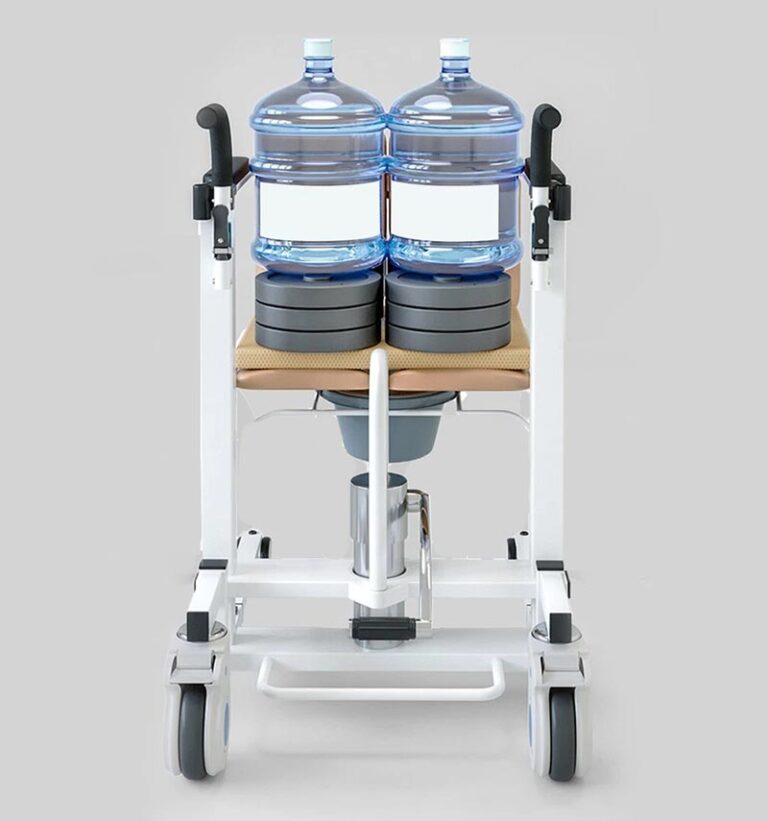
Electric transfer chairs are designed with simplicity and ease of use in mind, making them particularly beneficial for elderly or less physically able caregivers. The controls are typically intuitive and require minimal physical strength to operate. For example, instead of having to manually crank or pull levers to move the chair, caregivers can simply press a button to initiate the transfer process. This user-friendly design ensures that even those with limited physical capabilities can effectively and safely use the chair to assist patients. It also reduces the learning curve for new caregivers, allowing them to quickly become proficient in using the equipment and providing better care.
More Consistent Transfers Regardless of Caregiver Strength:
Manual transfers can sometimes result in inconsistent movements, depending on the strength and technique of the caregiver. This can be a concern, especially when dealing with patients who require gentle and precise handling.
Electric transfer chairs offer a more consistent transfer experience. The motorized mechanisms ensure that each transfer is carried out with the same level of smoothness and accuracy, regardless of the caregiver’s physical strength.
This consistency not only provides a more comfortable experience for the patient but also reduces the risk of complications or injuries that could occur due to uneven or rough transfers.
Reduced fatigue during multiple daily transfers: Caregivers often need to perform multiple patient transfers throughout the day, which can quickly lead to fatigue. This fatigue can not only affect the caregiver’s own well-being but also potentially impact the quality of care they provide.
Electric transfer chairs help alleviate this fatigue by taking over the physically demanding aspects of the transfer process.
Caregivers can use the chair to efficiently complete each transfer, saving their energy for other important tasks. This allows them to remain more focused and productive throughout the day, ultimately providing better care for their patients.
Electric transfer chairs represent a significant advancement in patient mobility assistance, offering enhanced safety, reduced physical strain, and greater independence for both users and caregivers.
Electric-vs-Manual-Transfer-Chair-Comparison
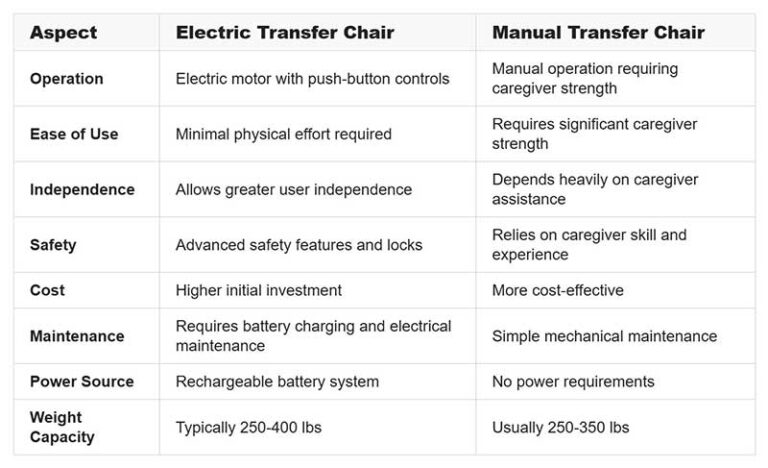
If you are looking for an electric transfer chair or other mobility aids suitable for your local market and business, please contact us. Ageally will find the most appropriate elderly-friendly transfer solution for you.
